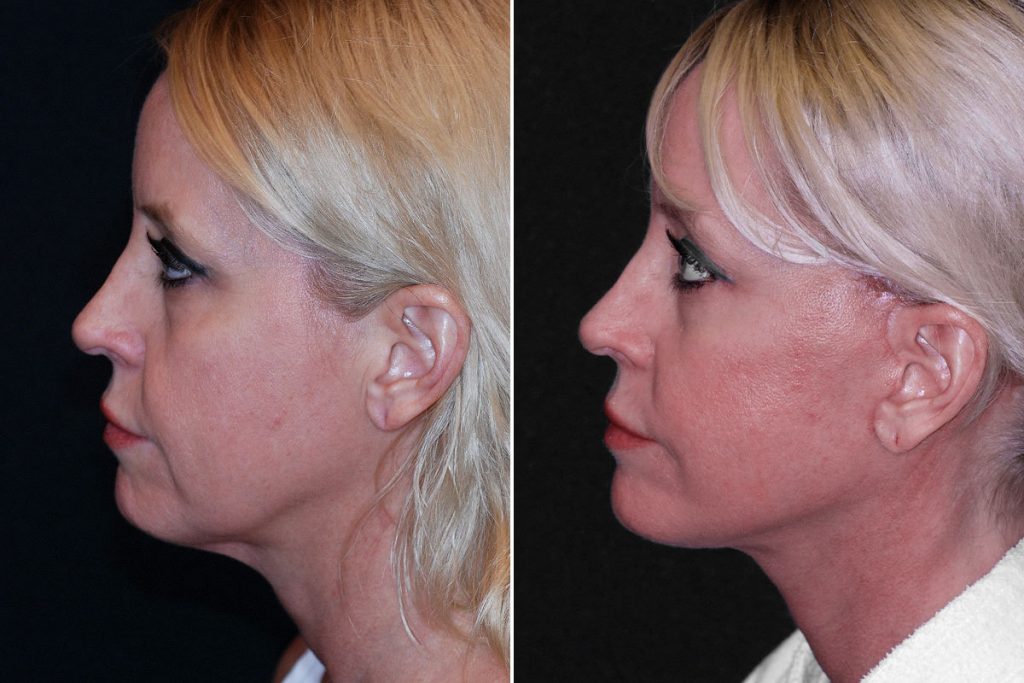
More patients in their 40s and 50s are seeking out facelifts. This phenomenon received media attention after Sonja Morgan of The Real Housewives of New York City underwent a deep plane facelift to correct relatively minor jowls and wrinkles. While her openness about the procedure got people’s attention, the results were also noteworthy—both natural-looking and precise.
Her updated look demonstrates how a deep plane facelift can be an appropriate and effective anti-aging choice, even for those without dramatic skin laxity. Dr. J. Kevin Duplechain specializes in this facelift technique, which he uses for all of his facelift procedures, whether minor or major. Today we’ll share his perspective on why a deep plane facelift is the most effective surgical technique to counteract visible aging in the face.
What’s the difference between a deep plane and a regular facelift?
All surgical types of facelift, or rhytidectomy, are intended to tighten the tissue and muscle along the cheeks, jawline, and neck to reduce signs of aging. That said, they differ in terms of technique and the results they will provide.
The SMAS facelift
The most common type of facelift procedure is the SMAS facelift (superficial musculoaponeurotic system facelift), in which the skin and superficial musculature is stretched and reattached, smoothing wrinkles and correcting sagging. While this procedure certainly can be effective, without a nuanced approach, the results are less than desirable: skin tightly pulled around aging musculature simply doesn’t look natural, and is a dead giveaway someone has had a standard facelift procedure.
The deep plane facelift difference
To give patients natural-looking results and to avoid this “windswept” look, Dr. Duplechain recommends the deep plane facelift, which tightens a deeper layer of musculature and thus avoids the problems associated with stretching facial skin. The deep plane facelift actually releases ligaments at a deeper level and repositions the musculature and tissues.
The deep plane facelift technique may be applied to just the midface, or to both the midface and neck area. In addition, Dr. Duplechain often removes or repositions fat deposits to redistribute fullness during the procedure. For example, herniated buccal fat (in the cheeks) is a common contributor to the appearance of jowls; this can be removed during the deep plane procedure.
Complementary procedures to enhance facelift results
To provide a more holistic rejuvenation, Dr. Duplechain suggests employing complementary procedures in addition to the deep plane facelift, including:
- Fat injections to restore volume
- Laser skin treatments to treat finer surface wrinkles
- RF treatments to encourage collagen renewal
- Liposuction under the chin to refine the profile
- Endoscopic eyelid suspension to address under-eye hollows, bags, and drooping lower lids
- Injectable dermal fillers or BOTOX® to further refine and maintain results
These will enhance your facelift results and create an overall appearance of restored youthfulness.
What results can I expect from a deep plane facelift?
After six months, you should be able to see the “final results” of the procedure. The midface will appear lifted, and you’ll find that a deep plane facelift corrects the following signs of aging:
- Fine lines and wrinkles
- Facial volume loss
- Jowls
- Double chin
- Neck wrinkles and “crepe-like” skin
This patient’s before-and-after photos demonstrate the natural quality of deep-plane facelift results. In the “after” image, this patient does not appear to have had a surgical procedure. The deep plane facelift simply “rewound the clock,” making her appear to be naturally younger. Her significant skin laxity has been improved without any stretching:

Where will I have deep plane facelift scars?
A deep plane facelift uses similar incisions to a SMAS facelift, at the lower part of the ears and behind the ears. Skillfully handled, their placement should be very inconspicuous. Caring properly for your scars post-procedure will help them fade until they are nearly invisible.
How long does a deep plane facelift last?
A deep plane facelift will set back the clock on your apparent age by 10+ years and this “reset” will be long-lasting—longer than that of a SMAS facelift, thanks to treatment of the underlying musculature. Facial aging will still continue, but you will always enjoy the advantage of looking younger than you would have without the procedure. Most patients are satisfied with deep plane facelift results for 10-15 years, after which those who want to renew a youthful look may desire a touch-up surgical procedure.
You can also choose to continuously maintain your results, using supporting procedures such as injectables, microneedling, laser & RF treatments at regular intervals. This is a popular approach among apparently ageless celebrities and Dr. Duplechain heartily recommends it over waiting for results to completely fade before seeking treatment.
How much does a deep plane facelift cost?
Deep plane facelifts range in cost from $15,000 to $25,000. For comparison, SMAS facelifts average from $10,000 to $15,000. A deep plane facelift is more costly than a regular facelift because the surgeon will be working with deeper layers of tissue and the procedure takes more skill and care.
What are the complications associated with a deep plane facelift?
Most potential complications are very similar to SMAS facelift surgery, but because a deep plane facelift involves additional layers of tissue, it carries a higher risk of nerve damage when compared with regular facelift. Thus it is imperative to choose a cosmetic surgeon with extensive deep plane facelift experience. Dr. Duplechain has spent most of the last 30 years of his career performing deep plane facelifts and is a true expert in this procedure.
The patient also has a part to play in avoiding complications: your safety also depends on disclosing all medications and health issues you may have before your procedure and following all pre- and post-procedure instructions to the letter. Patients who are actively smoking should not undergo facelift surgery as it increases the risk of skin loss 15 fold. Recovery after a deep plane facelift does take a little longer than other types of facelift, and therefore you should plan to take two weeks off of work. (If you can work from home at a computer, you may be able to return to the job sooner.) You will also need to avoid strenuous activity for six weeks.
Learn more about deep plane facelift in Lafayette, LA
Lafayette cosmetic surgeon Dr. Duplechain is a facelift expert, dedicated to using the most effective and safe surgical techniques. He has performed over 1,000 deep plane facelifts and teaches his refined surgical techniques to his peers around the nation. Men and women from all parts of Louisiana (and beyond) trust Dr. Duplechain to provide the most natural-appearing facelift procedure results.
To learn more or to schedule a consultation at our Lafayette surgical center, contact us today.

Leave a Reply